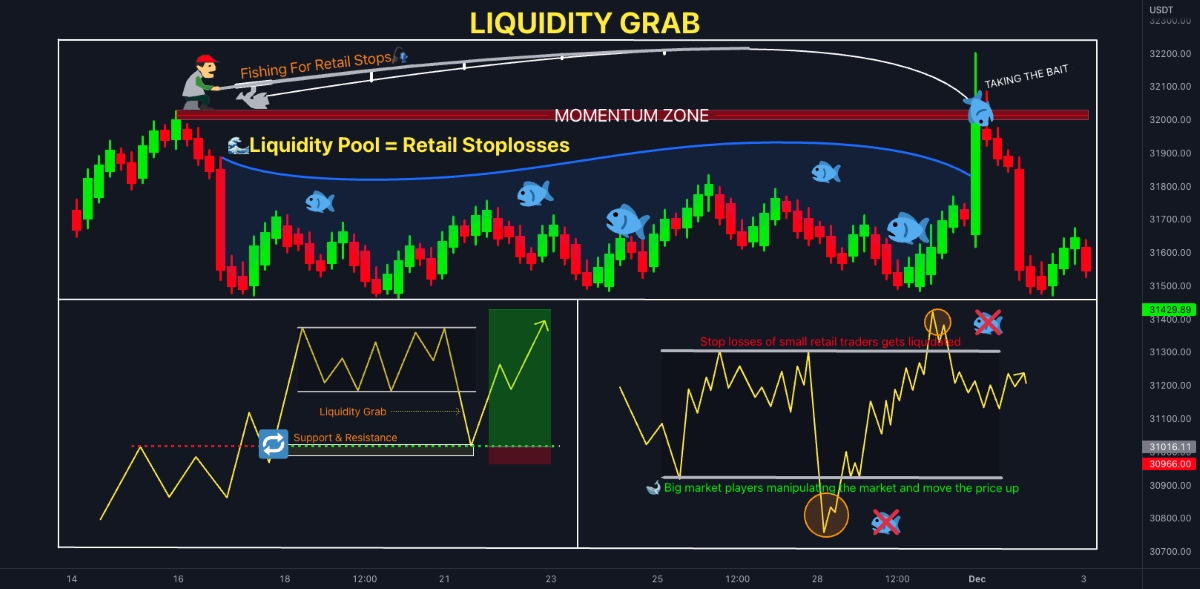

Finance
What Is Exit Liquidity?
Published: February 23, 2024
Learn about exit liquidity in finance and how it impacts investments and financial markets. Understand the significance of exit liquidity for investment strategies and decision-making.
(Many of the links in this article redirect to a specific reviewed product. Your purchase of these products through affiliate links helps to generate commission for LiveWell, at no extra cost. Learn more)
Table of Contents
Introduction
Exit liquidity is a crucial concept in the world of finance, especially in the realm of investments and business operations. It refers to the ability to convert an asset into cash quickly without significantly impacting its market price. This concept holds immense significance for investors, businesses, and financial institutions, as it directly impacts their ability to manage risk, optimize returns, and seize new opportunities.
In the context of investments, exit liquidity plays a pivotal role in determining the ease with which an investor can sell their holdings in a given asset. Whether it's stocks, bonds, real estate, or other financial instruments, the ability to swiftly exit a position can be a game-changer, especially during volatile market conditions. For businesses, exit liquidity influences their capacity to divest assets, undertake strategic acquisitions, or navigate challenging financial circumstances.
Understanding exit liquidity entails delving into the dynamics of market depth, trading volumes, bid-ask spreads, and the overall efficiency of the market in which the asset is being traded. It involves assessing the ease of finding a buyer or seller for a particular asset, as well as the potential impact of the transaction on the asset's price. A high level of exit liquidity implies that an asset can be easily converted into cash without causing a significant shift in its market value, while low exit liquidity indicates the opposite.
In this article, we will explore the intricacies of exit liquidity, its importance in various financial contexts, the factors that influence it, and strategies for enhancing exit liquidity. By gaining a comprehensive understanding of this concept, investors, businesses, and financial professionals can make informed decisions, mitigate risks, and optimize their financial positions. Let's delve into the realm of exit liquidity and unravel its multifaceted implications in the dynamic landscape of finance.
Understanding Exit Liquidity
Exit liquidity can be best understood as the ease and speed with which an investor or entity can sell an asset in the market without significantly impacting its price. It is a critical aspect of financial markets, as it directly influences the flexibility and risk exposure of market participants. When assessing exit liquidity, it is essential to consider the depth of the market for a specific asset, the volume of trading activity, and the bid-ask spread, which represents the difference between the highest price that a buyer is willing to pay and the lowest price that a seller is willing to accept.
Market depth, a key component of exit liquidity, refers to the extent to which an asset can be traded without causing substantial price movements. Deeper markets typically offer higher exit liquidity, as there is a larger pool of potential buyers and sellers, reducing the likelihood of significant price fluctuations during transactions. In contrast, shallow markets may exhibit lower exit liquidity, as trading activity is limited, and executing large transactions can exert notable influence on prices.
Exit liquidity is closely tied to the concept of market efficiency. In highly efficient markets, assets can be readily bought or sold at fair prices, reflecting all available information. This contributes to enhanced exit liquidity, as market participants can transact with minimal impact on prices. Conversely, in less efficient markets, where information is not fully reflected in asset prices, achieving exit liquidity may pose greater challenges, as transactions can lead to more pronounced price changes.
It’s important to note that different asset classes and financial instruments may exhibit varying levels of exit liquidity. For example, publicly traded stocks of large, well-established companies often feature high exit liquidity, given the active trading and broad investor interest. On the other hand, certain fixed income securities or less liquid stocks may present lower exit liquidity, as finding willing buyers or sellers can be more arduous.
By comprehending the nuances of exit liquidity and its underlying determinants, market participants can make informed decisions regarding their investment strategies, risk management approaches, and capital allocation. This understanding empowers investors and businesses to navigate the complexities of financial markets with greater acumen and agility, leveraging exit liquidity to optimize their financial positions and capitalize on emerging opportunities.
Importance of Exit Liquidity
Exit liquidity holds profound significance across various facets of finance, playing a pivotal role in shaping investment strategies, risk management practices, and the overall resilience of financial markets. Its importance reverberates throughout the realms of portfolio management, corporate finance, and market dynamics, influencing the decision-making processes of investors, businesses, and financial institutions.
For investors, exit liquidity directly impacts their ability to swiftly enter and exit positions in financial assets, thereby managing risk and optimizing returns. In the absence of adequate exit liquidity, investors may encounter challenges when seeking to sell their holdings, especially during market downturns or periods of heightened volatility. This can lead to diminished portfolio flexibility and the inability to capitalize on emerging opportunities or mitigate losses effectively.
Moreover, exit liquidity is closely intertwined with the concept of market liquidity, which reflects the ease with which assets can be bought or sold at stable prices. Market liquidity, underpinned by exit liquidity, fosters confidence among investors and contributes to the efficient functioning of financial markets. It enables capital to flow smoothly, facilitates price discovery, and supports the allocation of resources to their most productive uses.
In the realm of corporate finance, exit liquidity influences strategic decision-making processes for businesses. Whether it involves divesting non-core assets, pursuing mergers and acquisitions, or raising capital through asset sales, exit liquidity directly impacts the feasibility and execution of these initiatives. Adequate exit liquidity empowers companies to optimize their capital structures, seize growth opportunities, and navigate challenging economic conditions with greater agility.
Furthermore, the importance of exit liquidity extends to the stability and resilience of financial markets as a whole. Robust exit liquidity fosters market efficiency, reduces the impact of large transactions on asset prices, and enhances the overall transparency and functionality of markets. This, in turn, contributes to the mitigation of systemic risks and promotes investor confidence, bolstering the long-term sustainability of financial ecosystems.
By recognizing the pivotal role of exit liquidity in investment dynamics, corporate strategies, and market stability, stakeholders can proactively assess and manage exit liquidity risks, optimize their financial positions, and contribute to the overall robustness of financial systems. Cultivating a comprehensive understanding of exit liquidity empowers market participants to make informed decisions, adapt to evolving market conditions, and harness the potential of financial markets to achieve their objectives.
Factors Affecting Exit Liquidity
Exit liquidity is influenced by a myriad of factors that collectively shape the ease and efficiency of buying and selling financial assets in the market. Understanding these determinants is essential for investors, businesses, and financial professionals, as it enables them to assess and manage exit liquidity risks effectively. By delving into the key factors that affect exit liquidity, market participants can navigate the complexities of financial markets with greater insight and adaptability.
Market Depth: The depth of a market, characterized by the volume of buy and sell orders at varying price levels, plays a pivotal role in determining exit liquidity. Deeper markets, with a substantial number of active buyers and sellers, often exhibit higher exit liquidity, as there is a greater likelihood of executing transactions without significantly impacting prices. In contrast, shallow markets may present lower exit liquidity, as trading activity is limited, and executing large transactions can lead to notable price fluctuations.
Asset Class and Type: Different asset classes and financial instruments may demonstrate varying levels of exit liquidity. For instance, publicly traded stocks of large, well-established companies often feature high exit liquidity, given the active trading and broad investor interest. Conversely, certain fixed income securities or less liquid stocks may present lower exit liquidity, as finding willing buyers or sellers can be more challenging.
Market Efficiency: The efficiency of a market, characterized by the speed at which asset prices reflect all available information, significantly impacts exit liquidity. In highly efficient markets, assets can be readily bought or sold at fair prices, contributing to enhanced exit liquidity. Conversely, in less efficient markets, where information is not fully reflected in asset prices, achieving exit liquidity may pose greater challenges, as transactions can lead to more pronounced price changes.
Volatility and Economic Conditions: Market volatility and broader economic conditions exert notable influence on exit liquidity. During periods of heightened volatility or economic uncertainty, exit liquidity may diminish, as investors become more cautious, trading volumes fluctuate, and price movements intensify. Conversely, in stable economic environments with lower volatility, exit liquidity may be more pronounced, as market participants exhibit greater confidence and trading activity remains relatively steady.
Regulatory and Legal Framework: The regulatory environment and legal framework governing financial markets can impact exit liquidity. Stringent regulations, restrictions on trading activities, or legal barriers to asset transfers can impede exit liquidity, limiting the ease with which assets can be bought or sold. Conversely, transparent and well-regulated markets often foster higher exit liquidity, as they provide a conducive environment for market participants to transact with confidence.
By comprehensively evaluating these factors and their interplay within the dynamic landscape of financial markets, stakeholders can gain valuable insights into the determinants of exit liquidity. This understanding empowers them to proactively assess and manage exit liquidity risks, optimize their investment strategies, and capitalize on opportunities while navigating the multifaceted terrain of financial markets.
Strategies for Enhancing Exit Liquidity
Enhancing exit liquidity is a critical endeavor for investors, businesses, and financial institutions seeking to optimize their financial positions and mitigate liquidity risks. By implementing strategic approaches tailored to the dynamics of financial markets, market participants can bolster exit liquidity, thereby fostering greater flexibility, resilience, and risk management capabilities. Let’s explore key strategies for enhancing exit liquidity and navigating the intricacies of financial markets with acumen and agility.
Diversification: Diversifying investment portfolios across different asset classes, sectors, and geographies can contribute to enhanced exit liquidity. By spreading investments across a range of assets with varying levels of liquidity, investors can mitigate the impact of liquidity constraints in specific markets or asset types. Diversification can provide avenues for liquidity optimization while managing risks associated with exit liquidity variations across different investments.
Active Portfolio Management: Engaging in active portfolio management, characterized by ongoing monitoring and rebalancing of investment holdings, can bolster exit liquidity. By regularly assessing market conditions, liquidity dynamics, and the performance of individual assets, investors can make informed decisions to optimize their portfolios for enhanced exit liquidity. This proactive approach enables investors to capitalize on emerging opportunities and manage liquidity risks effectively.
Utilizing Derivatives and Hedging Instruments: Derivatives and hedging instruments can serve as valuable tools for managing exit liquidity risks. For instance, options and futures contracts can provide avenues for investors to hedge against potential liquidity constraints in their portfolios. By strategically utilizing these instruments, investors can enhance their ability to enter and exit positions in the market, thereby mitigating the impact of liquidity challenges on their investment strategies.
Building Relationships with Market Makers: Establishing relationships with market makers and liquidity providers can facilitate access to enhanced exit liquidity. Market makers play a vital role in facilitating trading activity and providing liquidity in financial markets. By leveraging relationships with reputable market makers, investors and businesses can potentially access deeper markets, reduced bid-ask spreads, and enhanced liquidity, thereby optimizing their ability to buy and sell assets efficiently.
Stress Testing and Scenario Analysis: Conducting stress testing and scenario analysis on investment portfolios can provide valuable insights into potential liquidity challenges and their impact on exit liquidity. By simulating various market conditions, economic scenarios, and liquidity stress events, investors can proactively identify vulnerabilities and refine their strategies to enhance exit liquidity resilience. This analytical approach empowers market participants to prepare for adverse liquidity conditions and optimize their portfolios accordingly.
Engaging with Regulatory and Legal Experts: Given the influence of regulatory and legal frameworks on exit liquidity, engaging with regulatory and legal experts can provide valuable guidance in navigating compliance requirements and optimizing liquidity strategies. Understanding the regulatory landscape, compliance obligations, and legal considerations pertaining to asset transfers and trading activities is essential for enhancing exit liquidity within a well-defined and compliant framework.
By embracing these strategic approaches and tailoring them to the specific dynamics of their investment objectives and market environments, stakeholders can proactively enhance exit liquidity, fortify their risk management capabilities, and optimize their financial positions. Cultivating a proactive and adaptive approach to managing exit liquidity empowers market participants to navigate the complexities of financial markets with resilience and agility, leveraging liquidity optimization to achieve their long-term objectives.
Conclusion
Exit liquidity stands as a cornerstone of financial markets, wielding profound implications for investors, businesses, and the overall stability of financial ecosystems. Its multifaceted influence permeates investment strategies, risk management practices, and the functionality of markets, underscoring the critical importance of understanding and optimizing exit liquidity.
By comprehending the intricacies of exit liquidity and its underlying determinants, market participants can navigate the complexities of financial markets with acumen and agility, leveraging liquidity optimization to achieve their long-term objectives. The ability to swiftly enter and exit positions in financial assets, manage risk, and capitalize on emerging opportunities hinges upon the presence of robust exit liquidity. It is a vital element that empowers investors and businesses to make informed decisions, optimize their financial positions, and contribute to the overall resilience of financial systems.
As market participants continue to navigate evolving market conditions, regulatory landscapes, and economic dynamics, the cultivation of enhanced exit liquidity resilience emerges as a strategic imperative. By embracing proactive portfolio management, diversification, strategic relationships with market makers, and a nuanced understanding of regulatory and legal considerations, stakeholders can fortify their exit liquidity capabilities and mitigate the impact of liquidity risks.
Ultimately, the pursuit of enhanced exit liquidity is a testament to the adaptability and foresight of market participants, as they seek to optimize their financial positions, navigate liquidity challenges, and contribute to the stability and efficiency of financial markets. By embracing strategic approaches tailored to the dynamics of financial markets, stakeholders can proactively enhance exit liquidity, fortify their risk management capabilities, and harness the potential of financial markets to achieve their objectives.
As the landscape of finance continues to evolve, the significance of exit liquidity resilience remains steadfast, serving as a cornerstone for informed decision-making, risk mitigation, and the optimization of financial positions. Through a comprehensive understanding of exit liquidity and the strategic enhancement of liquidity resilience, market participants can chart a course towards sustainable growth, resilience, and success in the dynamic and ever-evolving realm of finance.














